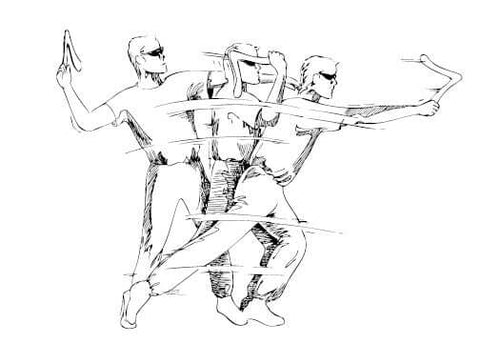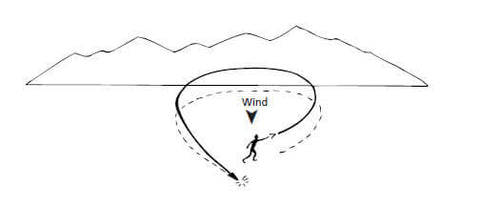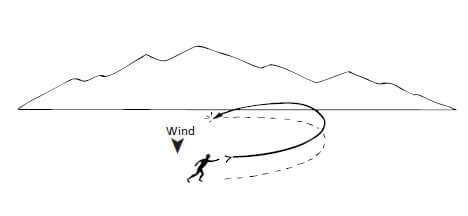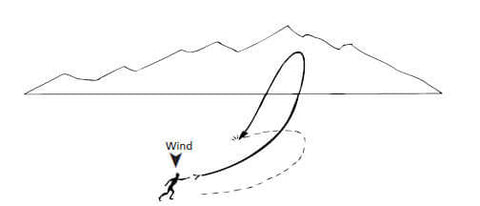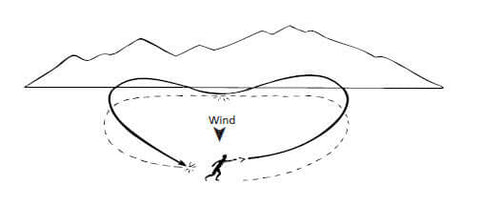How To Throw Boomerang Guide:
Getting your boomerang to return to you takes practice and experience. There is no exact or perfect way to throw each time since conditions are always different for each area and even different times through out the day. Throwing a boomerang is just like learning any other new sport and it does take time and practice to get it down right. The following diagrams and instructions are based on a right handed throw. Left handed throwers should always be to the left of the wind. For left handed throwers, imagine the diagrams inverted so that the wind and positioning is completely opposite of what you see.

The arm on the left (with hand) is the dingle arm. The arm on the right is the lead arm. Left-handed boomerangs would be opposite.
The Grip
The bottom of the boomerang (unpainted side) should be against your palm. The top (painted side) against your thumb. Remember, spin is more critical than a hard or forceful throw. Your grip should allow the boomerang to begin to spin (rotate) as it leaves your hand. Use what works best for you, and remember, spin is king!

Layout Zone
Throw no more than 45 degrees from vertical. Too laid over (sidearm) and the boomerang will climb too high and slide back towards the ground!! Proper layover will create a lower, more controlled flight. Not enough layover, see page 17. Each model requires a different degree of layover. A good rule of thumb is as the wind increases, come up closer to vertical. These guidelines apply to conventional “hobby” boomerangs. There are specially designed competition boomerangs for “Long Distance”, “MTA” and “Trick Catch” event throwing which involve different instructions. Please make sure to consult your throwing guide for those specific boomerangs before using. You can obtain more information and guidance about competition boomerang throwing by visiting www.boomerangs.tv, www.boomerangs.org or www.boomerangs.com.

Release Zone
Release the boomerang at a slight upward angle ( in relation to the horizon). A good rule of thumb is to aim at distant treetops. Keep it off the ground, but don’t put it in the clouds!! Too low of a release angle creates a high-climbing end of the flight. A touch more release height will create a level, more consistent flight.
Throw Zone
#1. Determine wind direction and velocity,
#2 Depending on the model, throw 40-60 degrees off the wind.
If the boomerang lands in front of you, throw more into the wind. If it lands behind you, throw more off the wind. You must know wind speed and direction prior to each throw. Right handed: throw right of the wind. Left handed: throw left of the wind. As you become more proficient, you will be able to handle more and more wind.
Throwing Motion
SPIN IS KEY! The throwing motion is similar to throwing a football. Let the boomerang fly out of your hand. Do not try to initiate the turn of the boomerang with your throw; it will turn itself. Pick a point in the distance that is the correct angle off the wind and throw. Remember, spin is king!! More spin, and snap… less muscle!
The Catch
Use good judgment when deciding when you should attempt a catch. You should not attempt to catch a boomerang until you are familiar with its flight path. Also, if the boomerang is coming in fast towards you, do not attempt a catch! Only go for the catch when the boomerang is hovering in softly towards you. Before long you will be catching like a pro.
In a calm wind, use a little more layover. The flight will be more elliptical with less wind.
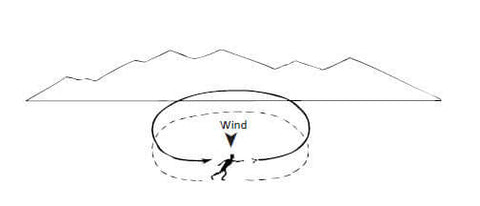
In normal wind conditions (8-12mph), throw with less power and less layover. The flight will be more round with wind.
Throwing too hard.
When thrown too hard, the flight will look like above.
Throwing Too Soft
When thrown too soft, the boomerang will not make it all the way back to you.
Throwing With Too Much Wind
When thrown too much into the wind the boomerang will land behind you… throw more off the wind. Righties throw right of the wind, and lefties throw left of the wind.
Throwing With Too Little Wind
When thrown too far off the wind the boomerang will land in front of you… throw more into the wind. Remember, righties throw right of the wind, and lefties throw left of the wind.
Too Much Layover
This is what happens when you use too much layover. (Too close to a sidearm throw.)
Not Enough Layover
This is what happens when you do not use enough layover. The layover was too vertical.
Warping
When your boomerang consistently sinks on the outbound part of the flight, check warp, bend the tips up.
Flextuning
When your boomerang climbs too high, too fast, check the warp. Try bending the tip down so the boomerang is flat.






